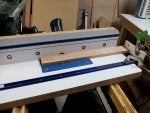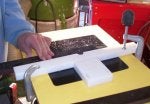Duane- Cast in t-slots in drill press tables and t-slots in OEM drill press tables... I use to mount vises, cross slide vises and hold down clamps. Some t-slots in OEM woodworking tables are used for mounting a fence. What I don't see a need for on a drill press table is a miter slot.
Mike- Made the TS explanation over-complicated. Once the saw is adjusted (which the miter slot is a reference) then the blade is just another cutting edge. If ascew, then just a wider cutting edge (cove). Having said- TS, bandsaws, shapers and router tables... manufactured... miter slots... built in feature.
Why? It's a precision reference. So what if its a bit, shaper cutter or blade. All the same - a cutting edge. The cutting edge doesn't move to the work, the work moves to the cutting edge. LOL. In a miter slot, you can use a miter bar, attached to a jig, sled, miter fence, guide, etc... Which helps the user control, support and move the work past the cutting edge.
Miter Slot versus Edge Guide on a jig or sled... Edge, you hold the sled or jig against the edge of the table, so if you don't keep it against the edge... When I use these, I feel like I should have another appendage. Miter Slot holds the same from getting further, closer, turning... And doesn't take me three hands to control the work.
Miter slotted attachments that I use on my router tables- box joint jig, dovetail jig, spline joint jig, rail fence, router sled, adjustable angle sled, miter sled, miter fence, feather boards.
I keep coming up with new ways to use my miter slots. Yet for router fences and attachments on a fence- I have many clamps.













